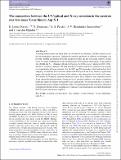The connection between the UV/optical and X-ray emission in the neutron star low-mass X-ray binary Aql X-1
Abstract
Accreting neutron stars and black holes in low-mass X-ray binaries (LMXBs) radiate across the electromagnetic spectrum. Linking the emission produced at different wavelengths can provide valuable information about the accretion process and any associated outflows. In this work, we study simultaneous X-ray and ultraviolet (UV)/optical observations of the neutron star LMXB Aql X-1, obtained with the Neil Gehrels Swift Observatory during its 2013, 2014, and 2016 accretion outbursts. We find that the UV/optical and X-ray emission are strongly correlated during all three outbursts. For the 2013 and 2014 episodes, which had the best Swift sampling, we find that the correlation between the UV/optical and X-ray fluxes is significantly steeper during the decay (soft state) of the outburst than during the rise (hard-to-soft state). We observe a UV/optical hysteresis behaviour that is likely linked to the commonly known X-ray spectral hysteresis pattern. For the decays of the three outbursts, we obtain a correlation index that cannot be directly explained by any single model. We suspect that this is a result of multiple emission processes contributing to the UV/optical emission, but we discuss alternative explanations. Based on these correlations, we discuss which mechanisms are likely dominating the UV/optical emission of Aql X-1.
Citation
Lopez-Navas , E , Degenaar , N , Parikh , A S , Santisteban , J V H & van den Eijnden , J 2020 , ' The connection between the UV/optical and X-ray emission in the neutron star low-mass X-ray binary Aql X-1 ' , Monthly Notices of the Royal Astronomical Society , vol. 493 , no. 1 , pp. 940-951 . https://doi.org/10.1093/mnras/staa275
Publication
Monthly Notices of the Royal Astronomical Society
Status
Peer reviewed
ISSN
0035-8711Type
Journal article
Description
EL-N gratefully acknowledges support from an ‘ERASMUS+ for traineeship’ grant, and is thankful for the hospitality of the Anton Pannekoek Institute, where most of this work was carried out. ND, ASP, JVHS, and JvdE were supported by a Vidi grant from the Netherlands Organisation for Scientific Research (NWO), awarded to ND. JVHS acknowledges support from a Science and Technology Facilities Council (STFC) grant ST/R000824/1.Collections
Items in the St Andrews Research Repository are protected by copyright, with all rights reserved, unless otherwise indicated.

